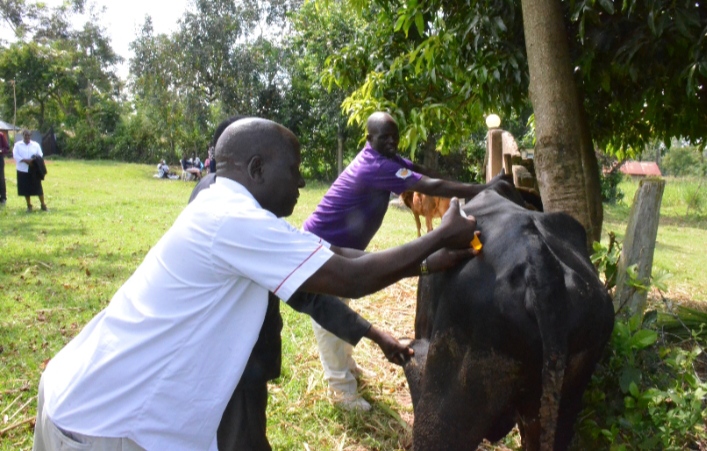Migori,
Thursday, March 14, 2024,
KNA BY Janemolly Achieng/Marion Obuya
Milk production in Migori is still low and, with the high demand for the precious commodity, the County milk entrepreneurs have been forced to relook at their strategies by outsourcing the commodity to satisfy the ever-growing population.
The County relies on small-scale farmers to supply milk that is sometimes unreliable or the commodity is too little to be supplied, ending up in nearby small households.
The County lack large-scale dairy farmers and for this reason, it is highly disadvantaged that it would soon improve on milk production. Although Nyatike Sub County, which is part of Migori, boasts a vast land that favours large-scale dairy farming, the major problem is the lack of intervention to establish and convert some of the areas into ranches.
The 2021 Migori milk statistics data showed the county had the potential to produce an average of 25 million litres of milk annually, a figure far lower than its demand of 88 million litres.
This data projection has forced a majority of local milk entrepreneurs to import milk from the far-flung neighbouring Counties of Narok, Bomet, Kericho and, even from the Tarime region in the Republic of Tanzania.Consequently, milk prices in Migori have continuously gone up since October 2023, where a litre of milk in the county used to retail between Shs 60 to Shs 65 to between Shs 75 to Shs 80 from March this year.
Eunice Atieno, one of the milk vendors in Migori town attributes the ever upward price trend of milk to transportation costs associated with milk outsourcing from other neighbouring counties.
“We are buying our milk from Transmara in Narok and sometimes as far as Bomet and Kericho because what we get from our local suppliers is little. This, has forced us, to incur the extra transport charges that we usually pass to our customers to maintain our little profits”, noted Atieno.
Transportation costs are one of the biggest contributors to milk price hikes within the County from the fact that the meagre production in the County cannot sustain the growing population which approximately stands at around 1.5 million residents.
According to Migori County Director of Livestock Charles Nyaanga, Migori County has made a lot of interventions to boost dairy farming in the region for milk production enhancement.
The introduction of one cow per tobacco farmer programme, the posting of livestock extension officers and efforts to improve immunisation and vaccination as well as the introduction of feed-making machinery to daily farmer groups to lower animal feed prices have all continued to bear fruits.
The County together with developmental partners like the National Agricultural and Rural Inclusive Growth Project (NARIGP), the Agricultural Sector Development Support Programme (ASDSP), Kenya Agricultural and Livestock Research Organisation (KARLO) and the Food and Agriculture Organisation (FAO) have been in the forefront in supporting the dairy farming through capacity building, Artificial Insemination (AI) services, the introduction of exotic breeds, disease and parasites control and feed subsidies and trainings to support the daily ventures in the County.According to the Kenya National Bureau of Statistics (KNBS) Livestock Population Census of 2019, only 4.5 Million daily cows from a population of 18.8 Million existed.
It is from these statistics that Nyaanga explains the need for proper interventions to boost milk production, especially in counties, Migori included, where daily farming has not yet picked up.
However, Nyaanga says that the perception that Migori County cannot be able to sustain exotic dairy breeds is what is dragging back the daily farming activities in the County. Although the county is hotter, areas like the sub-counties of Kuria, and parts of Uriri and Suna have conducive environments to sustain exotic dairy animals.
The County is not considered a high agro-ecological zone for dairy farming but according to Nyaanga, the county can benefit most by mating pure breeds and ingenious ones to improve the genetic survival of the combined breeds as well as realise improved milk production.
He notes that milk production in the county can be improved if the daily farmers can join empowered cooperatives for milk value addition at aggregation centres instead of milk hawkers The low milk production in the county can also be attributed to the past cattle rustling in the Kuria region which saw a lot of dairy farmers quit the lucrative venture for fear of losing their animals to cattle rustlers. Although the vice has reduced in recent times, the community has not fully embraced the venture leading to reduced milk production in the county.
Nyaanga however discloses that residents are slowly embracing the venture after KARLO intervention.
The dairy farmers in the County have been benefiting from cheap-priced exotic and improved calves from the Oyani Livestock multiplication Centre located in Uriri Sub County.
The County has also been providing subsidized Artificial Insemination services to formal groups greatly reducing the animal disease transmission from bull servings.
The County together with its daily farming developmental partners is in the process of creating a strategic plan to introduce daily goats to reduce over-dependency of cow milk as well as improve nutrient intake, especially in the Semi-Arid region of Nyatike.
Nyaanga added that the usage of the vernacular radio talk shows on the importance of using homemade feeds and their right ration has helped farmers to improve milk production, reduce production costs and over dependant on commercial feeds.
The county, he explained, through the Department of Agriculture has been assisting daily farmers by giving out feed-making machines for home-based raw materials and supplying folder seeds like the Super Napier that grows faster to boost their folder production.
Courtesy; KNA





